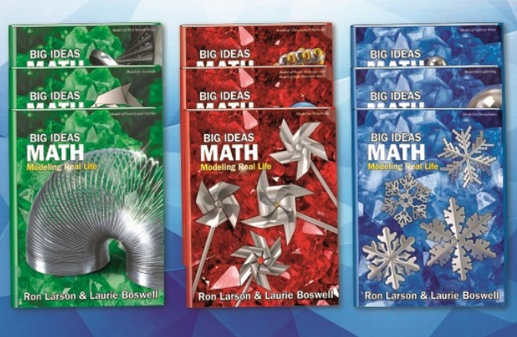5. Core Resource Selection

Being intentional and thoughtful in selecting a core resource was important as the selection is a five-year commitment and we want students and teachers to have the best possible resources supporting instruction. A commitment (and expected outcome) was that within each of the three levels (K-5, 6-8, 9-12) a common core resource would be used so that students experience consistency in language and format as they move from grade to grade within that level. The middle school had been utilizing Big Ideas Math (National Geographic Learning/Cengage) with great success over the past few years and chose to recommend it for the core resource at that level. At the elementary level, math team members reviewed samples and participated in presentations from four vendors and chose two for further exploration. The elementary team then met again and analyzed and compared those two programs in twelve areas:
Features of Big Ideas that impressed the teachers included Laurie's Notes (a teacher providing an overview of important things to keep in mind when planning for and teaching concepts in each chapter), Progressions (a quick chart showing for each lesson the related skills students learned the prior year and the related skills students will learn the next year), Learning Targets and Success Criteria (identifies clearly what a student will be learning and the mathematical behaviors the student should be able to demonstrate if they have learned the skills or concepts being taught - the success criteria can be used as quick formative assessments to monitor individual learning and adjust instruction), Scope and Sequence (this nicely aligned with the teacher-developed scope and sequence and differences were easily adjusted for), K-5 Literacy Component (supporting literacy development even while learning math is important), Cross-curricular Components (relating math to other disciplines helps see the real world value in learning mathematics), Professional Development Resources (to help teachers continue to grow in their effectiveness), Math Musicals (incorporates song into learning math at the early grades - research has shown strong ties between learning music and mathematical growth), ELL Support (language barriers should not impede mathematical growth), and Real Life Applications (showing students how math relates to their everyday life is important for sustained engagement).
- Scope & Sequence
- Student materials
- Use of manipulatives
- Literacy inclusion
- RtI inclusion
- Differentiation across spectrum
- Rigor
- State assessment prep
- Teacher support materials
- Pacing
- Assessment
- Technology
- Number sense
Features of Big Ideas that impressed the teachers included Laurie's Notes (a teacher providing an overview of important things to keep in mind when planning for and teaching concepts in each chapter), Progressions (a quick chart showing for each lesson the related skills students learned the prior year and the related skills students will learn the next year), Learning Targets and Success Criteria (identifies clearly what a student will be learning and the mathematical behaviors the student should be able to demonstrate if they have learned the skills or concepts being taught - the success criteria can be used as quick formative assessments to monitor individual learning and adjust instruction), Scope and Sequence (this nicely aligned with the teacher-developed scope and sequence and differences were easily adjusted for), K-5 Literacy Component (supporting literacy development even while learning math is important), Cross-curricular Components (relating math to other disciplines helps see the real world value in learning mathematics), Professional Development Resources (to help teachers continue to grow in their effectiveness), Math Musicals (incorporates song into learning math at the early grades - research has shown strong ties between learning music and mathematical growth), ELL Support (language barriers should not impede mathematical growth), and Real Life Applications (showing students how math relates to their everyday life is important for sustained engagement).